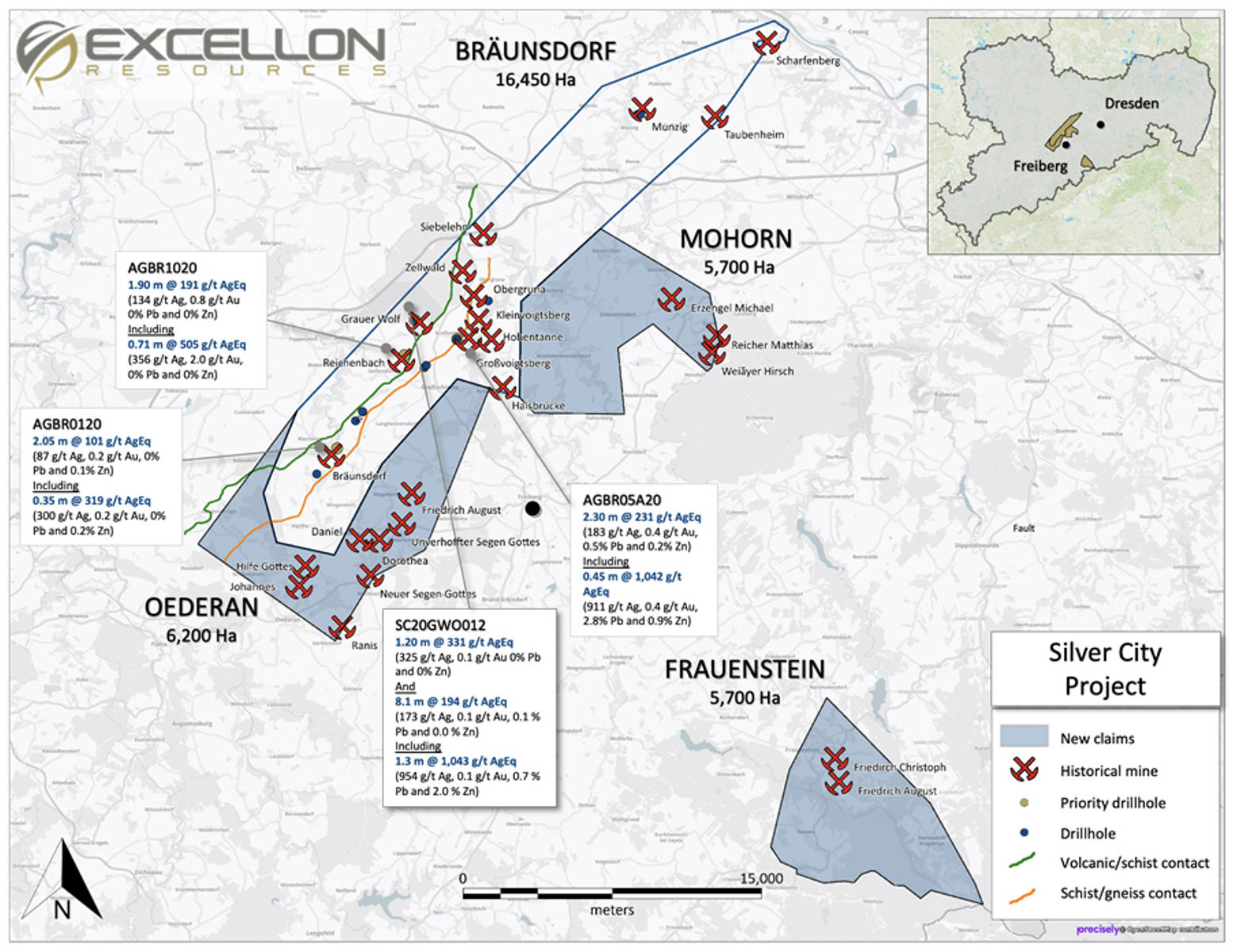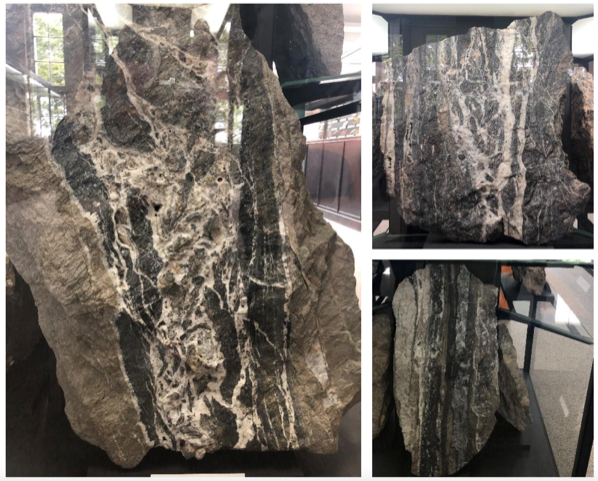- Germany has been integral to silver production historically, including the Rammelsberg Mine that produced for over 1,000 years continuously through 1988.
- Excellon has a license to explore a massive land package, dubbed “Silver City,” after the heritage name for Freiberg (Silberstadt), spanning 341.5 square kilometers that has produced billions of dollars in silver from shallow depths.
- Excellon is a first mover in Saxony, with the first drilling using modern technology cutting 1,042 g/t AgEq, while defining a major epithermal silver system over 12 kilometers.
If someone could do a flyby of the history of silver, they would cover the globe and witness annual production go from a few nuggets around 3,000 BCE to 800 million ounces in 2019 (https://nnw.fm/1YM7c). From a time perspective, the majority of the journey would be spent throughout Europe where mining was integral to economies, empires and technical revolutions for centuries before Europeans landed in North American and silver production grew in Mexico. Germany, inclusive of the Rammelsberg Mine, where silver, copper and lead were mined continuously for over 1,000 years through 1988, was once a vibrant part of the industry; particularly after the Vikings had looted coastal Europe of most of its silver by 900 CE. Several contributing factors led to silver production all but disappearing in Germany today, although more days of Rammelsberg-like activity could lie ahead thanks to companies like Excellon Resources (TSX: EXN) (NYSE American: EXN) (FSE: E4X2) bringing modern technology to historically prolific regions.
Saxony: If a Picture is Worth 1,000 Words…

If a picture is indeed worth 1,000 words, it begs the question what two Baroque-era copperplate engravings are worth depicting the history of silver mining in Saxony, Germany (https://nnw.fm/Xfo9p). Amongst other things, the engravings include a cross section of a hillside recreating multiple levels of underground mining activity at Saxony’s Ore Mountains, or Erzgebirge, and a string of miners working by torchlight to send buckets of ore to the surface via a hand-turned wench.
Silver mining underscored the provincial wealth on full display in the capital city of Dresden going back to the Middle Ages, which remains renowned for its Baroque-style architecture to this day, including historic buildings that were reconstructed after being destroyed during World War II. Today, visitors can take a trip back in time along the 275-kilometer Saxon-Bohemian Silver Mines Route, passing through Dresden en route to more than 30 visitor mines showing off over eight centuries of mining heritage (https://nnw.fm/NMEoA).
History Being Made Today
About 20 kilometers west of Dresden, Excellon has a license to explore a district-scale land package named “Silver City.” It spans an area of 34,150 hectares (341.5 square kilometers) that has a history of more than 750 years of historical production, with exactly zero modern exploration for precious metals. The property, which is connected to the well-known Freiberg Mining Field, was originally optioned from project generator Globex Mining Enterprises (TSX: GMX) (OTCQX: GLBXF) in 2019 at approximately 164 square kilometers. In March, Excellon more than doubled its position by adding the Frauenstein, Mohorn, and Oederan exploration licenses, giving the company an unparalleled ground position covering historical high-grade silver mines on an epithermal silver belt with veins as wide as 10 meters and grading up to 3,700 grams per tonne (g/t) silver (Ag) (https://nnw.fm/6mv26).
Again, sometimes a picture illustrates far more than any description of the property could, demonstrating just how many historical Saxony mines are enveloped in Silver City. Importantly, despite high-grade, near-surface silver (and other metals), mining depth at the 26 mines identified scarcely breached 200 meters simply owing to a lack of technology.

Mining in the Freiberg district – just east of Bräunsdorf – began around 1162 and ran nearly continuously through 1969. Silver output from the district is estimated at more than 5,000 tonnes of silver (~180 million ounces worth about $5 billion at today’s prices). Interestingly, indium and germanium were also discovered in the Freiberg district in the 1800’s, metals that are now considered critical by the European Commission (https://nnw.fm/IzeV8). Other metals found in the district include lead, zinc, copper, barite, fluorite, and smaller amounts of cobalt and nickel.

Freiberg mineralogical galleries have a spectacular collection of mineral samples from historical mines that demonstrate the similarity between the region’s geology and that of Mexican epithermal belts. These samples each contain multi-kilogram per tonne silver (https://nnw.fm/aBTbP). This delves into a spate of technical nomenclature to explain why and how the rock formed over millions of years that is often best kept to geologists, but it certainly provides quantitative and qualitative insight into the potential for re-igniting mining in Saxony.
Excellon knows a bit about Mexican silver geology, considering its Platosa mine is Mexico’s highest-grade silver mine in production.
Speaking of Bräunsdorf, the area forming that license historically produced at least 882 tonnes of silver, worth nearly $800 million at today’s $27.50 per ounce price. A sampling of other historic mining production within the Bräunsdorf area alone includes:
- Halsbrücke (Großschirma) – 319.6 t Ag, 46,381 t Pb, 370 t Cu, 3,000 t barite, 341 t fluorite.
- Großvoigtsberg – 31.5 t Ag
- Hohentanne – 10.0 t Ag
- Kleinvoigtsberg 192.8 t Ag
- Obergruna 159.0 t Ag + Cu and Zn
- Siebenlehn – 0.77 t Ag
- Munzig – 0.89 t Ag
- Scharfenberg 55 t Ag, 1,907 t Pb
As simply and eloquently stated by Globex when they acquired the property in 2017 (https://nnw.fm/kU6FS), “due to the long period of the mining history and incomplete records, it is impossible to know the complete mining production from the Bräunsdorf license area but it is clearly a significant mining belt.” The same could be said for the dozens of mines along the 35-kilometer stretch of Silver City.
So Why Now? A Return to the Logical
Silver production in Germany certainly didn’t diminish over the years because of a lack of resources. The metal faced other hurdles, though. Amongst the historic culprits, demand for silver was reduced when Germany introduced the gold standard in the 1870s to replace silver-based currencies. Challenges related to overburden and mining below the water table made new discoveries impossible and mining uneconomic, with the technology at the time. Add in stubbornly low prices in the 1900’s and German silver mining was essentially kaput.
All of those challenges are gone today. Excellon is a first mover in a bid to capitalize on the growth opportunity and pro-mining regulations in a very proud mining region. The initial drilling last year at Bräunsdorf was the first for precious metals in the region to use modern technology and didn’t disappoint, assaying as high as 1.3m @ 1,043 g/t silver equivalent while striking a major epithermal silver system over 12 kilometers, confirming high-grade silver species and discovering high-grade silver veins. Assays are currently pending from eight additional drill holes at Silver City, which could be the start of putting Germany back on the silver map like it was so many years ago.
For more information, visit the company’s website at www.ExcellonResources.com.
NOTE TO INVESTORS: The latest news and updates relating to EXN are available in the company’s newsroom at https://nnw.fm/EXN
About NetworkNewsWire
NetworkNewsWire (“NNW”) is a financial news and content distribution company, one of 40+ brands within the InvestorBrandNetwork (“IBN”), that provides: (1) access to a network of wire solutions via InvestorWire to reach all target markets, industries and demographics in the most effective manner possible; (2) article and editorial syndication to 5,000+ news outlets; (3) enhanced press release solutions to ensure maximum impact; (4) social media distribution via IBN millions of social media followers; and (5) a full array of corporate communications solutions. As a multifaceted organization with an extensive team of contributing journalists and writers, NNW is uniquely positioned to best serve private and public companies that desire to reach a wide audience comprising investors, consumers, journalists and the general public. By cutting through the overload of information in today’s market, NNW brings its clients unparalleled visibility, recognition and brand awareness. NNW is where news, content and information converge.
To receive SMS text alerts from NetworkNewsWire, text “STOCKS” to 77948 (U.S. Mobile Phones Only)
For more information, please visit https://www.NetworkNewsWire.com
Please see full terms of use and disclaimers on the NetworkNewsWire website applicable to all content provided by NNW, wherever published or re-published: http://NNW.fm/Disclaimer
NetworkNewsWire (NNW)
New York, New York
www.NetworkNewsWire.com
212.418.1217 Office
Editor@NetworkNewsWire.com
NetworkNewsWire is part of the InvestorBrandNetwork
No comments:
Post a Comment